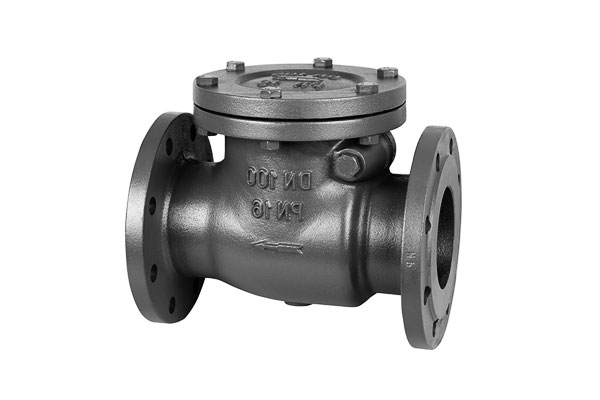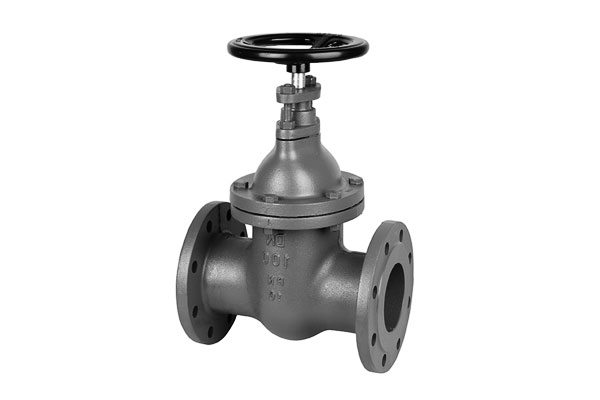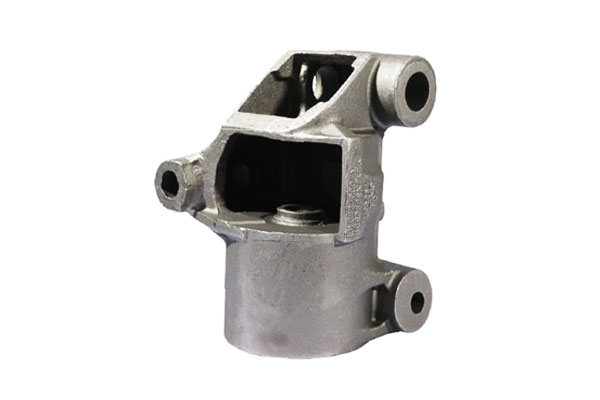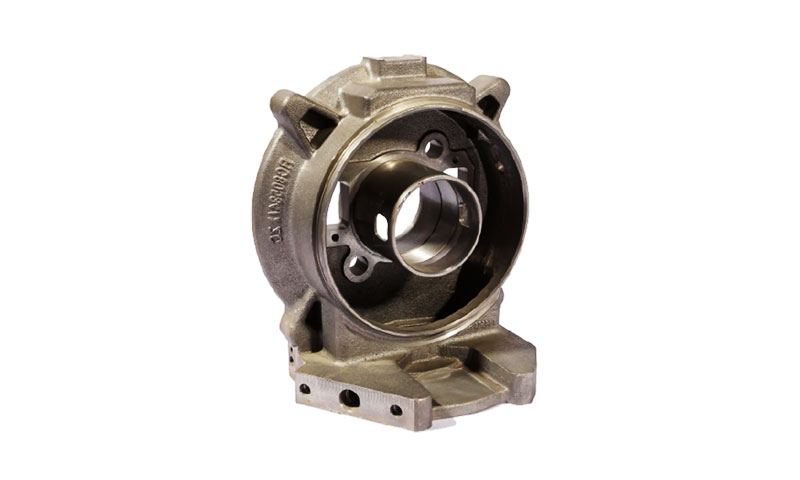1. Indledning
EN-GJL-250 is a widely used grade of grey cast iron specified in European practice.
The designation indicates a grey-iron casting with a guaranteed minimum tensile strength around 250 MPA and a flake-graphite microstructure.
EN-GJL-250 is chosen when koste, rollebesætning, vibration damping and excellent machinability are the priorities — for example machine-tool bases, motorblokke, pump housings and brake discs.
2. What Is Grey Iron EN-GJL-250?
EN-GJL-250:
- I — European standard designation style.
- GJL — grey cast iron (graphite flake morphology).
- 250 — designates the minimum tensile strength in MPa (Dvs., ≈250 MPa).
Grey iron EN-GJL-250 is a widely used cast iron grade in European standards, defined under I 1561.
It is characterized by lamellær (flage) graphite dispersed in a metallic matrix, typically a combination of pearlite and ferrite.
The “250” in the designation refers to a minimum tensile strength of approximately 250 MPA, ensuring predictable mechanical performance for structural castings.
EN-GJL-250 is commonly employed for components requiring God bearbejdelighed, damping capacity, og moderat styrke, making it a cost-effective choice for medium-duty industrial parts.

Funktioner
- Flake Graphite Microstructure: The graphite flakes interrupt the metallic matrix, giving the material Fremragende vibrationsdæmpning og chip-breaking behavior Under bearbejdning.
- Moderate Tensile Strength: Minimum tensile strength of ~250 MPa provides adequate performance for many structural applications while retaining brittleness in tension.
- God bearbejdelighed: The flake graphite acts as a built-in lubricant and chip breaker, tillader efficient machining with reduced tool wear.
- Omkostningseffektiv: Tilgængelighed af råvarer, straightforward casting processes, and low finishing requirements make EN-GJL-250 economical for complex shapes.
- Termisk ledningsevne: Higher thermal conductivity than many steels allows effective heat dissipation, beneficial in engine blocks, brake discs, and machine tool bases.
- Begrænsninger: Sprød under trækspænding, challenging to weld, and prone to shrinkage/porosity if casting controls are not carefully managed.
EN-GJL-250 is thus a versatile “workhorse” grey iron grade, ideal where compressive loads, Vibrationsdæmpning, og bearbejdelighed are prioritized over tensile ductility.
3. Typical Chemistry & Mikrostruktur
Below are representative chemical ranges and the microstructural characteristics found in EN-GJL-250 castings.
These ranges are typical shop targets — always verify with supplier certificates.
| Element | Typical wt% Range | Fungere / Noter |
| Kulstof (C) | 3.0 – 3.8 | Provides carbon for graphite flakes; higher C increases graphite content and improves damping but reduces tensile strength. |
| Silicium (Og) | 1.8 – 3.0 | Promotes graphite formation and influences matrix (ferrite vs pearlite balance). |
| Mangan (Mn) | 0.10 – 0.80 | Acts as a deoxidizer and controls hardness; high Mn can promote carbides. |
| Fosfor (S) | 0.05 – 0.15 | Increases fluidity in casting but excessive P may cause brittleness. |
| Svovl (S) | 0.02 – 0.12 | Low S is preferred to avoid formation of iron sulfide which can cause brittleness; works with Si to control graphite morphology. |
| Jern (Fe) | Balance (~≥ 93%) | Main metallic matrix, combines with C and Si to form pearlite/ferrite structures. |
Microstructure Notes
- Grafit flager: Dispersed in the matrix, acting as stress concentrators in tension but excellent for vibration damping and machinability.
- Matrix: Typisk pearlitic or ferritic-pearlitic, where higher pearlite content increases hardness and tensile strength, and more ferrite improves ductility and machinability.
- Key process influence: Inokulation, kølehastighed, and melt chemistry control graphite flake size, fordeling, and matrix fraction.
4. Mekaniske egenskaber & Typical Data
Representative mechanical properties for EN-GJL-250 castings (values vary with matrix and casting practice; supplier certificates should be used for design):
| Ejendom | Typical value / rækkevidde | Noter |
| Trækstyrke, Rm | ≥ 250 MPA | Minimum design requirement; cast-to-test coupon results often 250–320 MPa depending on matrix |
| Forlængelse (EN) | ~0.2 – 2.0 % | Low tensile ductility — grey iron is brittle in tension |
| Trykstyrke | ~600 – 1 200 MPA | Concretely higher than tensile strength; useful for compressive load design |
| Brinell hardness (HBW) | ~140 – 260 Hb | Ferritic lower end; pearlitic/harder matrix upper end |
| Elastikmodul, E | ~100 – 170 GPA (typical ~110–150 GPa) | Reduced by graphite flakes vs solid steel |
| Damping capacity | Høj | One of grey iron’s main advantages — excellent vibration absorption |
5. Fysiske egenskaber & Thermal Behaviour
| Ejendom | Typical value (typ.) |
| Termisk ledningsevne | ~40 – 60 W·m⁻¹·K⁻¹ (depends on matrix) |
| Koefficient for termisk ekspansion (CTE) | ≈ 10 – 12 ×10⁻⁶ K⁻¹ |
| Termisk stabilitet | Good up to moderate temperatures; high temperatures alter matrix and strength |
| Specific heat capacity | ~460 – 500 J·kg⁻¹·K⁻¹ |
| Densitet | ≈ 7.0 – 7.3 g·cm⁻³ |
6. How it is produced — foundry practice and key control levers
Producing consistent EN-GJL-250 castings requires control of melt chemistry, inokulation, moulding and cooling:

- Smeltning & charge: skrot, pig iron and alloy additions melted in cupola or induction furnaces.
- Inokulation: adding small amounts of Fe-Si, ferrosilicon or other inoculants at pouring promotes graphite nucleation and shapes flake morphology. Proper inoculation reduces chill and white iron.
- Moulding & afkøling: sand moulds, shell moulds eller Investeringsstøbning kan bruges.
Cooling rate controls matrix: slow cooling → more ferrite; faster cooling → more pearlite and higher hardness. - Sulfur control & Magnesium: sulfur is managed to control graphite formation; unlike ductile iron, magnesium is not added to produce spheroidal graphite — graphite remains flake shaped.
- Post-casting treatments: stress-relief annealing, tempering or surface treatments may be applied for dimensional stability and reduced residual stress.
Quality in foundry practice is achieved through process control (melt analysis, inoculant recipes, Termisk styring) and sound gating/feeding design to minimise porosity and shrinkage.
7. Bearbejdningsevne, joining and surface treatments
Bearbejdningsevne
- Fremragende bearbejdelighed relative to steels due to graphite flakes acting as chip breakers and lubricants.
Tool life is generally good and feeds/speeds can be higher than for steels of equivalent strength. - Cutting characteristics depend on matrix: ferritic matrix — very easy; pearlitic — harder but still good.
Deltag i (svejsning & lodding)
- Welding grey iron is udfordrende because of graphite and variable shrinkage; brazing and mechanical fastening are often preferred.
If welding is required, Forvarm, suitable electrodes and post-weld heat treatment are usually necessary — consult a welding engineer and perform qualification tests.
Surface treatment & beskyttelse
- Painting and coatings for corrosion protection are common.
- Shot peening or surface hardening may be used for wear applications but are limited by the brittle nature in tension.
- Porosity sealing (imprægnering) may be applied to hydraulic castings to make them leak-tight.
8. Design considerations & engineering best practice
EN-GJL-250 is excellent when used correctly — these are typical design tips:
- Design for compressive and bending loads rather than tensile shock loads. Graphite flakes act as crack initiators in tension.
- Avoid high tensile stress concentrations — large fillets, smooth transitions, and generous radii reduce stress raisers.
- Use ribbing and sectioning to increase stiffness without inducing thermal‐shrinkage defects. Keep sections reasonably uniform or design chills/cores to control solidification.
- Account for anisotropy — due to directional solidification and graphite orientation, properties can vary with casting direction.
Consider specifying gating and mould layout to get favorable graphite orientation relative to principal stresses. - Service temperature limits: elevated temperatures can alter matrix and reduce strength — consult data for high-temperature applications.
9. Fordele og begrænsninger
Advantages of EN-GJL-250
- Fremragende bearbejdelighed — low manufacturing cost for complex geometries.
- High damping — reduces vibration, improves surface finish in machine tools.
- Good compressive strength & slidadfærd when pearlitic matrices are used.
- Omkostningseffektiv — economical raw material and tooling costs for cast components.
Limitations of EN-GJL-250
- Low tensile ductility — brittle fracture under tensile concentration.
- Difficult to weld — welding requires specialist procedures and qualification.
- Porosity/shrinkage risk — requires good foundry practice and NDT for critical parts.
- Anisotropy due to graphite flake orientation — care needed in design and gating.
10. Applications — Why Designers Choose EN-GJL-250
Typical applications where EN-GJL-250 is a natural choice:

- Maskinværktøjsbaser & rammer — stiffness + damping → improved machining accuracy.
- Motorblokke & Cylinderhoveder (many designs) — castability and machinability at reasonable cost.
- Pumpe & Ventillegemer, Gearhuse — complex near-net shapes with good wear behavior.
- Brake discs, svinghjul — thermal conductivity and damping useful in automotive and industrial brakes.
- Hydrauliske huse & Gearkassehus — machinable, dimensionally stable castings.
11. Equivalent Grades Across Global Standards
EN-GJL-250 is widely recognized and has direct equivalents in major international standards, which simplifies global procurement, design comparison, and material specification.
While chemical compositions may vary slightly, these equivalents are matched primarily by minimum tensile strength (~ 250 MPa) and flake graphite microstructure.
| Regional Standard | Karakterbetegnelse | Key Matching Criterion |
| European (I) | EN-GJL-250 | Minimum tensile strength ≥ 250 MPA (I 1561) |
| German (FRA) | GG25 | Former DIN designation; similar tensile strength and flake graphite structure |
| Chinese (GB/T.) | HT250 | Minimum tensile strength ≥ 250 MPA (GB/T. 9439) |
| American (Astm) | ASTM A48 klasse 35 | Minimum tensile strength 246 MPA (35 KSI) |
| International (ISO) | ISO 185 Klasse 250 | Aligned with EN 1561 Mekaniske krav |
| Japanese (Det er han) | JIS FC250 | Comparable composition and minimum tensile strength 250 MPA |
| Russian (Gost) | SCH25 | Minimum tensile strength ≥ 250 MPA (Gost 1412) |
Note for engineers and buyers: Always verify the Mekaniske egenskaber, graphite class, og kemisk sammensætning in supplier certificates rather than relying solely on nominal grade names, as slight variations in matrix structure can affect performance, bearbejdningsevne, and damping.
12. Comparison with Related Iron Grades
For designers selecting cast iron, it is useful to compare EN-GJL-250 with neighboring grey iron grades (En-GJL-200, EN-GJL-300) and a representative ductile iron grade (En-GJS-400-15) to understand differences in mechanical performance and applications.
| Ejendom / Materiale | En-GJL-200 (Lower Grade) | EN-GJL-250 | EN-GJL-300 (Higher Grade) | Duktilt jern (En-GJS-400-15) |
| Trækstyrke, Rm (MPA) | 200–240 | 250–320 | 300–370 | 400–450 |
| Forlængelse, EN (%) | 0.3–1.5 | 0.2–2.0 | 0.2–2.5 | 12–15 |
| Brinell hårdhed (Hb) | 120–180 | 140–260 | 180–300 | 170–230 |
| Trykstyrke (MPA) | 400–600 | 600–1.200 | 700–1.400 | 700–1,500 |
| Dæmpningskapacitet | Høj | Høj | Medium | Moderat |
| Bearbejdningsevne | Fremragende | Fremragende | God | God |
| Brittleness / Tensile Ductility | High brittleness | High brittleness | Slightly lower brittleness | Low brittleness, høj duktilitet |
| Typiske applikationer | Low-load housings, small components | Maskinbaser, Pumpehuse, motorblokke | Higher-strength grey iron components, Bær dele | Strukturelle komponenter, high-load gears, pressure-containing parts |
Analyse:
- EN-GJL-250 is the “balanced” grey iron grade: Moderat trækstyrke, fremragende dæmpning, and machining efficiency, making it ideal for medium-duty structural castings.
- En-GJL-200 is softer, cheaper, and better suited for low-stress components.
- EN-GJL-300 has higher strength, Velegnet til heavier-duty applications but with slightly reduced machinability and damping.
- Duktilt jern (En-GJS-400-15) Tilbud high tensile strength and ductility, making it the choice for load-bearing or fatigue-critical components, though damping and machinability are lower than grey iron.
13. Konklusion
EN-GJL-250 is a versatile and economical grey cast iron grade widely used in industry wherever Vibrationsdæmpning, good machinability and castability er nødvendige.
Its guaranteed minimum tensile strength (~ 250 MPa) makes it predictable for many applications, but designers must be conscious of its brittle tensile behavior, limited weldability and potential for casting defects.
Successful use of EN-GJL-250 depends on thoughtful design, strict foundry controls (inoculation and cooling), and well-specified inspection/acceptance criteria.
FAQS
Is EN-GJL-250 machinable?
Yes — grey cast iron is among the easiest engineering materials to machine because graphite flakes break chips and provide local lubrication.
Matrix (pearlitic vs ferritic) affects tool life and recommended feeds/speeds.
Can I weld EN-GJL-250?
Welding is possible but difficult. Specialized procedures (Forvarm, matched filler, controlled interpass temps, Retning efter svejsning) and qualification testing are required.
Brazing or mechanical fastening are often preferred.
What is the difference between EN-GJL-200 and EN-GJL-250?
Numbers reflect minimum tensile strengths (≈200 MPa vs ≈250 MPa). The higher number typically corresponds to a more pearlitic matrix or different processing to achieve higher strength.
How should I specify acceptance on drawings?
Specify EN-GJL-250, required tensile strength (Rm ≥ 250 MPA), hardness range, graphite flake class or matrix fraction if necessary, and required NDT (Radiografi, ultralyd) and machining allowances.
What causes graphite flake orientation and why does it matter?
Graphite flakes tend to align perpendicular to heat flow during solidification. Orientation affects anisotropy: mechanical properties are often better across flake direction than along it.
Designers should consider mould layout and gating to orient flakes favorably relative to principal loads.


